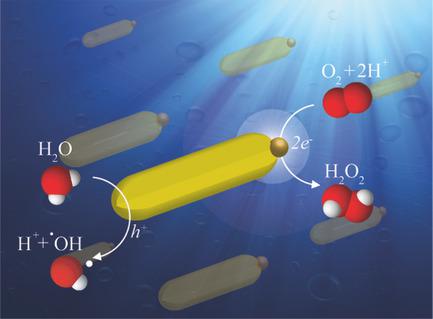当前位置:
X-MOL 学术
›
Adv. Mater.
›
论文详情
Our official English website, www.x-mol.net, welcomes your
feedback! (Note: you will need to create a separate account there.)
Photocatalytic Hybrid Semiconductor–Metal Nanoparticles; from Synergistic Properties to Emerging Applications
Advanced Materials ( IF 27.4 ) Pub Date : 2018-04-14 , DOI: 10.1002/adma.201706697 Nir Waiskopf 1 , Yuval Ben-Shahar 1 , Uri Banin 1
Advanced Materials ( IF 27.4 ) Pub Date : 2018-04-14 , DOI: 10.1002/adma.201706697 Nir Waiskopf 1 , Yuval Ben-Shahar 1 , Uri Banin 1
Affiliation

|
Hybrid semiconductor–metal nanoparticles (HNPs) manifest unique combined and often synergetic properties stemming from the materials combination. These structures exhibit spatial charge separation across the semiconductor–metal junction upon light absorption, enabling their use as photocatalysts. So far, the main impetus of photocatalysis research in HNPs addresses their functionality in solar fuel generation. Recently, it was discovered that HNPs are functional in efficient photocatalytic generation of reactive oxygen species (ROS). This has opened the path for their implementation in diverse biomedical and industrial applications where high spatially temporally resolved ROS formation is essential. Here, the latest studies on the synergistic characteristics of HNPs are summarized, including their optical, electrical, and chemical properties and their photocatalytic function in the field of solar fuel generation is briefly discussed. Recent studies are then focused concerning photocatalytic ROS formation with HNPs under aerobic conditions. The emergent applications of this capacity are then highlighted, including light‐induced modulation of enzymatic activity, photodynamic therapy, antifouling, wound healing, and as novel photoinitiators for 3D‐printing. The superb photophysical and photocatalytic properties of HNPs offer already clear advantages for their utility in scenarios requiring on‐demand light‐induced radical formation and the full potential of HNPs in this context is yet to be revealed.
中文翻译:

光催化混合半导体–金属纳米粒子;从协同特性到新兴应用
半导体-金属杂化纳米粒子(HNP)表现出独特的结合特性,并且通常由于材料的结合而产生协同作用。这些结构在吸收光时会在半导体-金属结之间表现出空间电荷分离,从而使其可用作光催化剂。到目前为止,HNP中光催化研究的主要动力是解决其在太阳能发电中的功能。最近,发现HNP在有效的光催化生成活性氧(ROS)中起作用。这为在多种生物医学和工业应用中实施这些方法开辟了道路,在这些应用中,高空间上在时间上分辨的ROS形成是必不可少的。在此,总结了有关HNP协同特性的最新研究,包括其光学,电学,简要讨论了太阳能发电领域中的化学性质及其光催化功能。然后,最近的研究集中在好氧条件下与HNPs形成光催化ROS。然后强调了这种能力的新兴应用,包括光诱导的酶活性调节,光动力疗法,防污,伤口愈合以及作为3D打印的新型光引发剂。HNP的超强光物理和光催化特性为其在需要按需光诱导的自由基形成的场景中的应用提供了明显的优势,并且在这种情况下,HNP的全部潜力尚待揭示。然后,最近的研究集中在好氧条件下与HNPs形成光催化ROS。然后强调了这种能力的新兴应用,包括光诱导的酶活性调节,光动力疗法,防污,伤口愈合以及作为3D打印的新型光引发剂。HNP的超强光物理和光催化特性为其在需要按需光诱导的自由基形成的场景中的应用提供了明显的优势,并且在这种情况下,HNP的全部潜力尚待揭示。然后,最近的研究集中在好氧条件下与HNPs形成光催化ROS。然后强调了这种能力的新兴应用,包括光诱导的酶活性调节,光动力疗法,防污,伤口愈合以及作为3D打印的新型光引发剂。HNP的超强光物理和光催化特性为其在需要按需光诱导的自由基形成的场景中的应用提供了明显的优势,并且在这种情况下,HNP的全部潜力尚待揭示。
更新日期:2018-04-14
中文翻译:

光催化混合半导体–金属纳米粒子;从协同特性到新兴应用
半导体-金属杂化纳米粒子(HNP)表现出独特的结合特性,并且通常由于材料的结合而产生协同作用。这些结构在吸收光时会在半导体-金属结之间表现出空间电荷分离,从而使其可用作光催化剂。到目前为止,HNP中光催化研究的主要动力是解决其在太阳能发电中的功能。最近,发现HNP在有效的光催化生成活性氧(ROS)中起作用。这为在多种生物医学和工业应用中实施这些方法开辟了道路,在这些应用中,高空间上在时间上分辨的ROS形成是必不可少的。在此,总结了有关HNP协同特性的最新研究,包括其光学,电学,简要讨论了太阳能发电领域中的化学性质及其光催化功能。然后,最近的研究集中在好氧条件下与HNPs形成光催化ROS。然后强调了这种能力的新兴应用,包括光诱导的酶活性调节,光动力疗法,防污,伤口愈合以及作为3D打印的新型光引发剂。HNP的超强光物理和光催化特性为其在需要按需光诱导的自由基形成的场景中的应用提供了明显的优势,并且在这种情况下,HNP的全部潜力尚待揭示。然后,最近的研究集中在好氧条件下与HNPs形成光催化ROS。然后强调了这种能力的新兴应用,包括光诱导的酶活性调节,光动力疗法,防污,伤口愈合以及作为3D打印的新型光引发剂。HNP的超强光物理和光催化特性为其在需要按需光诱导的自由基形成的场景中的应用提供了明显的优势,并且在这种情况下,HNP的全部潜力尚待揭示。然后,最近的研究集中在好氧条件下与HNPs形成光催化ROS。然后强调了这种能力的新兴应用,包括光诱导的酶活性调节,光动力疗法,防污,伤口愈合以及作为3D打印的新型光引发剂。HNP的超强光物理和光催化特性为其在需要按需光诱导的自由基形成的场景中的应用提供了明显的优势,并且在这种情况下,HNP的全部潜力尚待揭示。











































 京公网安备 11010802027423号
京公网安备 11010802027423号